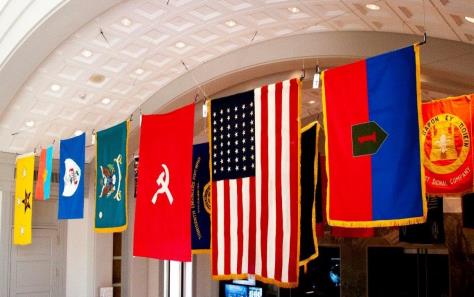


years after the park, it was called the Cantigny War Memorial Museum of the First Division. The present-day and much larger First Division Museum opened in 1992 and received a major renovation in 2017—the earliest fruit of Cantigny’s Project New Leaf.
“65 Years” also highlights the museum’s leadership and key changes through the years.
“The exhibit is meant to be nostalgic for all the families and guests who have come to the park for generations, as well as a chance to share our deep connection to the First Division and its members,” said Jessica Waszak, assistant curator.
That connection begins with Colonel Robert R. McCormick, Cantigny’s benefactor, who served in the First Division during World War I. The museum honors his legacy and the service and sacrifice of all military veterans, telling their stories and the story of America’s military experience through the lens of the 1st Infantry Division or “Big Red One.”
The items in “65 Years” represent the mundane and the momentous, from boots, helmets, and cigarette lighters to heroic patches, medals, and flags. They depict the everyday lives of soldiers while commemorating exceptional lives of service and sacrifice for our country.
Some of the nearly 500 artifacts will be on public display for the first time. The objects are organized into 17 categories, with emphasis on soldiers’ personal stories. Underlying the exhibit is the trust that artifact donors extend to the museum in its role of stewarding precious family memorabilia and narratives.
Admission to “65 Years” at the First Division Museum is included with paid admission to Cantigny Park. For more information, visit Cantigny.org.
###
About the First Division Museum at Cantigny Park
The First Division Museum, part of the Chicago-based Robert R. McCormick Foundation and located at Cantigny Park in Wheaton, Illinois, promotes public learning about America’s military heritage and affairs through the history of the “Big Red One”—the famed 1st Infantry Division of the U.S. Army. The museum’s main exhibit hall, First in War, transports visitors to the trenches of World War I, the beaches of World War II, and the jungles of Vietnam. A second exhibit hall, Duty First, explores the 1ID’s history in more recent times. The Robert R. McCormick Research Center, open to the public, houses the museum’s library, archival and photo collections. Tanks from every era are outside the museum, along with artillery pieces and a personnel carrier. Memorial markers and commemorative statuary pay further tribute to those who served. For more information, visit FDMuseum.org.